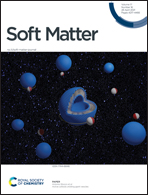Sequential and cellular detection of copper and lactic acid by disaggregation and reaggregation of the fluorescent panchromatic fibres of an acylthiourea based sensor†
Abstract
We report, for the first time, the self-assembly of an acyl-thiourea based sensor, N-{(6-methoxy-pyridine-2-yl) carbamothioyl}benzamide (NG1), with panchromatic fluorescent fibres and its dual-sensing properties for the sequential detection of Cu2+ ions and lactic acid. The panchromatic fibres formed by NG1 were disrupted in the presence of Cu2+ ions and this was accompanied by a visible colour change in the solution from colourless to yellow. The addition of lactic acid to the NG1 + Cu2+ solution, on the other hand, induced re-aggregation to fibrillar structures and the colour of the solution again changed to colourless. Hence, it may be surmised that the disaggregation and re-aggregation impart unique dual-sensing properties to NG1 for the sequential detection of Cu2+ ions and lactic acid. The application of NG1 as a selective sensor for Cu2+ ions and lactic acid has been assessed in detail by UV-visible and fluorescence spectroscopy. Furthermore, two structural variants of NG1, namely, NG2 and NG3, were synthesized, which suggest the crucial role of pyridine in imparting panchromatic emission properties and of both pyridine and acyl-thiourea side chain in the binding of Cu2+ ions. The O-methoxy group plays an important part in making NG1 the most sensitive probe of its structural analogs. Finally, the utility of NG1 for the sequential and cellular detection of Cu2+ ions and lactic acid was studied in human RPE cells. The experimental results of the interaction of NG1 with Cu2+ ions and lactic acid have also been validated theoretically by using quantum chemical calculations based on density functional theory (DFT). To the best of our knowledge, this is the first report wherein a dual sensor for Cu2+ ions and lactate ions is synthesized. More importantly, the aggregation properties of the sensor have been studied extensively and an interesting correlation of the photophysical properties of the probe with its self-assembling behavior has been elucidated.



 Please wait while we load your content...
Please wait while we load your content...